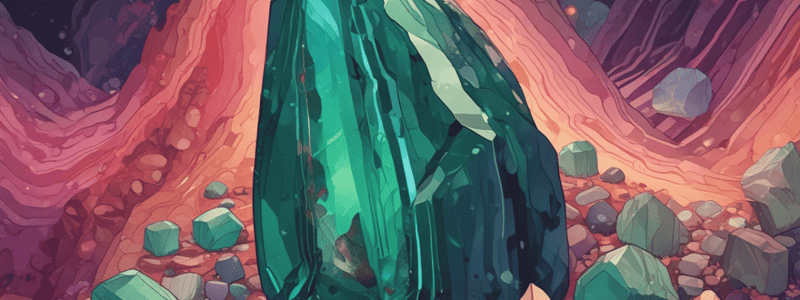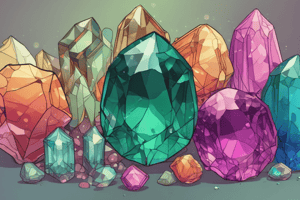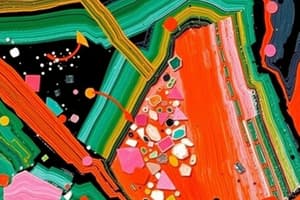Podcast
Questions and Answers
What is the main reason for the high prices of Paraíba tourmaline?
What is the main reason for the high prices of Paraíba tourmaline?
- Rapid temperature changes
- Heating and irradiation treatments
- Attractive, highly saturated hues and strong demand (correct)
- Formation in pegmatites
What is the primary source of large, fine-color peridot?
What is the primary source of large, fine-color peridot?
- Brazil
- Arizona
- Nigeria
- Myanmar (correct)
Why are some tourmaline crystals more valuable as mineral specimens?
Why are some tourmaline crystals more valuable as mineral specimens?
- Because of their rarity
- Due to their strong pleochroism
- Because they have well-formed, fine colors (correct)
- Due to their brittleness
What is necessary for cutters to achieve the best colors in tourmaline gems?
What is necessary for cutters to achieve the best colors in tourmaline gems?
Why is colorless zircon easily distinguishable from diamond?
Why is colorless zircon easily distinguishable from diamond?
What is the primary source of the world's gem-quality tourmaline?
What is the primary source of the world's gem-quality tourmaline?
What is the best way to clean peridot?
What is the best way to clean peridot?
What causes the extraordinary colors of Paraíba tourmaline?
What causes the extraordinary colors of Paraíba tourmaline?
What is necessary to handle zircon with care?
What is necessary to handle zircon with care?
What is true about blue and colorless zircons?
What is true about blue and colorless zircons?
What is the primary characteristic that all tourmalines share?
What is the primary characteristic that all tourmalines share?
What is the main purpose of heating and irradiation in tourmaline treatment?
What is the main purpose of heating and irradiation in tourmaline treatment?
Why are slender proportions often used in fashioning tourmaline gems?
Why are slender proportions often used in fashioning tourmaline gems?
What is the result of tourmaline's strong pleochroism?
What is the result of tourmaline's strong pleochroism?
Which of the following countries is NOT a significant source of tourmaline?
Which of the following countries is NOT a significant source of tourmaline?
What is the characteristic that distinguishes colorless zircon from diamond?
What is the characteristic that distinguishes colorless zircon from diamond?
Why does zircon require care in handling and wear?
Why does zircon require care in handling and wear?
What is the source of the world's commercial calibrated peridot?
What is the source of the world's commercial calibrated peridot?
What is the characteristic that makes some tourmaline crystals more valuable as mineral specimens?
What is the characteristic that makes some tourmaline crystals more valuable as mineral specimens?
Why is it best to clean peridot with warm water and mild detergent or soap?
Why is it best to clean peridot with warm water and mild detergent or soap?
What type of tourmalines are most gem tourmalines?
What type of tourmalines are most gem tourmalines?
What is the primary reason for the high demand of Paraiba tourmaline?
What is the primary reason for the high demand of Paraiba tourmaline?
What treatment is commonly used to enhance the color of tourmaline?
What treatment is commonly used to enhance the color of tourmaline?
Why do cutters have to orient finished tourmaline gems carefully?
Why do cutters have to orient finished tourmaline gems carefully?
What is the primary source of the world's gem-quality tourmaline?
What is the primary source of the world's gem-quality tourmaline?
What is the trade name for pink to red elbaite tourmaline?
What is the trade name for pink to red elbaite tourmaline?
What is the Indicolite?
What is the Indicolite?
What type of mineral has been broken down from crystalline to a partly amorphous state by emanations from radioactive impurities?
What type of mineral has been broken down from crystalline to a partly amorphous state by emanations from radioactive impurities?
What is the term used for a gem that shows color zoning with two or more colors?
What is the term used for a gem that shows color zoning with two or more colors?
What elbaite gem has color zoning made of a pink central zone surrounded by a green overgrowth?
What elbaite gem has color zoning made of a pink central zone surrounded by a green overgrowth?
Which two gems are prone to abrasions ?
Which two gems are prone to abrasions ?
Flashcards are hidden until you start studying
Study Notes
Tourmalines
- Group of minerals with same crystal structure but different chemical and physical properties
- Most gem tourmalines are elbaites that form in pegmatites
- Heating and irradiation are the two most important tourmaline treatments
- Well-formed, fine-color tourmaline crystals are more valuable as mineral specimens than as fashioned gems
- Cutters have to fashion gems with slender proportions due to the shape of many tourmaline crystals
- Strong pleochroism requires careful orientation of finished gems to achieve the best colors
- Brazil is the main supplier of the world's gem-quality tourmaline
Peridot
- Sensitive to rapid temperature changes and chemicals, so clean with warm water and mild detergent or soap
- Sources in Myanmar supply the world with most of its large, fine-color peridot
- Arizona supplies the world with rough for much of its commercial calibrated peridot
Paraíba Tourmaline
- High prices due to attractive, highly saturated hues, extremely restricted supply, and strong demand
- Traces of copper cause its extraordinary colors
Zircon
- Colorless zircon has strong double refraction, easily distinguishable from diamond and synthetic cubic zirconia
- Require care in handling and wear due to brittleness
- Virtually all blue and colorless zircons have been treated
- Nigeria and Mozambique are Africa's most economically important tourmaline sources
Tourmalines
- Group of minerals with same crystal structure but different chemical and physical properties
- Most gem tourmalines are elbaites that form in pegmatites
- Heating and irradiation are the two most important tourmaline treatments
- Well-formed, fine-color tourmaline crystals are more valuable as mineral specimens than as fashioned gems
- Cutters have to fashion gems with slender proportions due to the shape of many tourmaline crystals
- Strong pleochroism requires careful orientation of finished gems to achieve the best colors
- Brazil is the main supplier of the world's gem-quality tourmaline
Peridot
- Sensitive to rapid temperature changes and chemicals, so clean with warm water and mild detergent or soap
- Sources in Myanmar supply the world with most of its large, fine-color peridot
- Arizona supplies the world with rough for much of its commercial calibrated peridot
Paraíba Tourmaline
- High prices due to attractive, highly saturated hues, extremely restricted supply, and strong demand
- Traces of copper cause its extraordinary colors
Zircon
- Colorless zircon has strong double refraction, easily distinguishable from diamond and synthetic cubic zirconia
- Require care in handling and wear due to brittleness
- Virtually all blue and colorless zircons have been treated
- Nigeria and Mozambique are Africa's most economically important tourmaline sources
Tourmalines
- Tourmalines are a group of minerals with the same crystal structure but varying chemical and physical properties.
- Most gem tourmalines are elbaites, forming in pegmatites.
- Heating and irradiation are the two most important tourmaline treatments.
Value and Demand
- Paraíba tourmaline’s high prices result from a combination of attractive, highly saturated hues, extremely restricted supply, and strong demand.
- Well-formed, fine-color tourmaline crystals can be more valuable as mineral specimens than as fashioned gems.
Cutting and Cleaning
- The shapes of many tourmaline crystals force cutters to fashion gems with slender proportions.
- Cutters must orient finished gems carefully to achieve the best colors due to tourmaline’s strong pleochroism.
- Peridot is sensitive to rapid temperature changes and chemicals, requiring cleaning with warm water and mild detergent or soap.
Sources
- Brazil supplies the majority of the world’s gem-quality tourmaline.
- Myanmar is the primary source of large, fine-color peridot.
- Arizona supplies the world with rough for much of its commercial calibrated peridot.
- Nigeria and Mozambique are Africa’s most economically important tourmaline sources.
Zircon
- Colorless zircon’s strong double refraction easily distinguishes it from diamond and synthetic cubic zirconia.
- Traces of copper cause Paraíba tourmaline’s extraordinary colors.
- Virtually all blue and colorless zircons have been treated.
- Zircon requires care in handling and wear due to its brittleness.
Studying That Suits You
Use AI to generate personalized quizzes and flashcards to suit your learning preferences.


